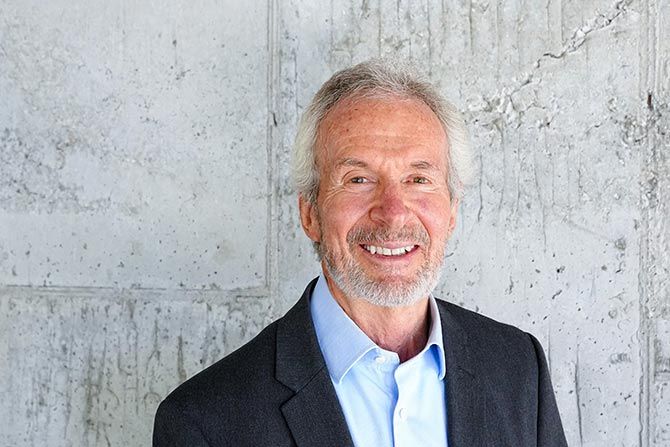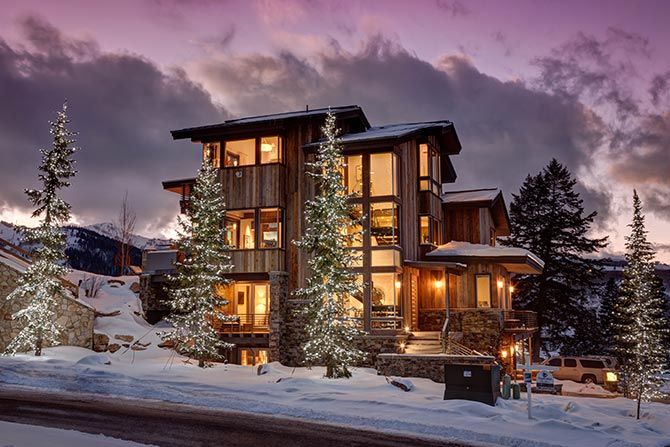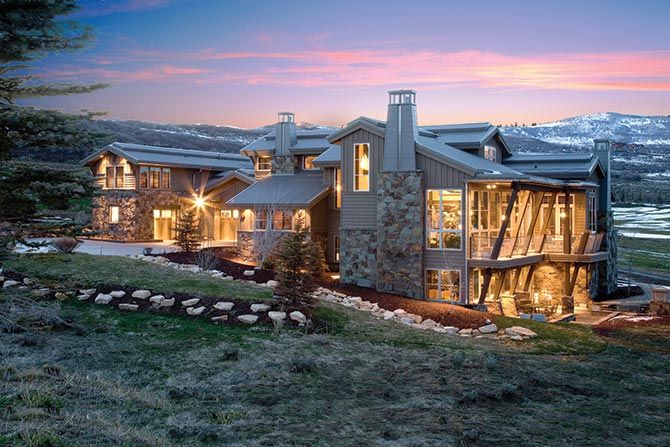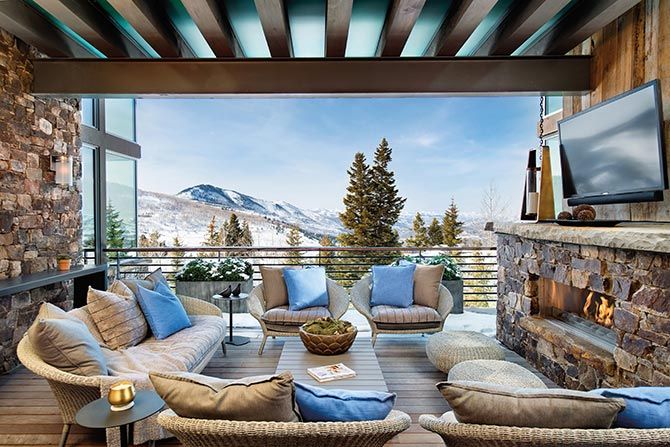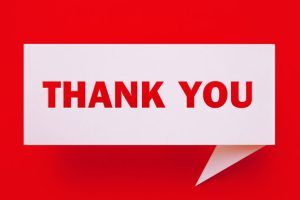In this edition, we continue our interviews with local architectural legends. We spoke with John Shirley about his beginnings, life, education and career.
When did you decide to become an architect?
When I was a boy, I loved Tinker Toys, American bricks. I loved to build things, and I just thought I would like to be an architect. In high school in Southern California, we had to take a class that researched an occupation.
I thought, “This is perfect,” because I really wasn’t that aware of what architects do except to get to draw great stuff. I found this survey that showed all the education an architect needs, how many years that takes, and how long he has to apprentice before getting his license. And then, after you were licensed, they showed that a window washer in San Francisco made almost twice as much money as an architect after four years of experience. It kind of squelched my dream. I then left the country for a couple of years, serving a mission for The Church of Jesus Christ of Latter-day Saints.
When I came back, I started at Santa Monica College, taking General Ed because I wasn’t sure what direction I wanted to go. I had one class in the same building that all the architecture classes were: a rendering class – watercolors, markers and so forth. I thought, “I’ve got to take that class.” So, I took it. The professor said, “You really have a talent. You should go into architecture.” At that point, I finally decided it wasn’t about the money. It was about the love of what you’re doing. I figured if you’re good at what you’re doing, the money will come. Maybe it didn’t come in as big as I was looking for. But I certainly love the profession.
Tell us about your training.
While I was at Santa Monica College, I met my wonderful wife and we moved to the University of Utah. I love to ski, so it made sense. I graduated first in Urban Planning, which was then in the Geography Department. Then I went to architecture school. While I was attending school, I worked pretty much the entire time. At first, I took construction jobs during the summer and even during Christmas break a couple of times.
My first architecture job during school was with the Silver Alsop. Roy Silver had me doing cabinet drawings in isometric. Back then, everything was ink on Mylar. Then I worked for Ken Millard, who was a planner and an architect, but his practice was mostly in planning. It was a really good experience. I think it’s had a huge impact on my career as the majority of my career is focused on residential. When you’re doing condominiums and subdivision work, you start with planning. I approach planning thinking architecture at the same time. I’m thinking density, heights, uses, and so forth. So, by the time I finish a master plan, I also have a pretty good idea of what the product’s going to be.
When did you graduate?
In 1980. [That year] also ushered in a recession. Here I had my degree; I was ready to go. Two years later, I could get my license, but there was hardly any work out there. I think many of us can relate to Tom Wolfe’s book, From Bauhaus to our House. One of his central themes was that every great architect, and I’m not claiming to be a great architect, all do their mother’s home. What got us through that recession was that I designed and built my mother’s addition on her home. By the time it was done, the economy had picked up, and things improved.
It wasn’t long after school that my best friend, Bruce McKnight, another friend, Bob Timmerman, and I started our own firm: McKnight, Shirley, Timmerman. In hindsight, I’m not sure that’s the best advice I would give somebody right out of school. One of the things I discovered is that in architecture school, you learn a lot about design and construction, but they don’t teach you anything about business. I would advise any architecture school that there should be mandatory classes on business because you come out of school assuming you’re this great new artist, and really you’re supposed to be a business person, but with no experience.
That was tough, sustaining the business, keeping the money flowing. I think we were in business together for a year or two. Then Bruce moved back to New York, and Bob and I split. That’s when John Shirley and Associates was created.
One of my first large jobs as an independent architect was the Red Pine Townhomes at the Park West Ski Resort. The resort’s owner, Jack Roberts, was an attorney from Los Angeles who thought he was living the dream by buying a ski resort because he loved to ski. He discovered that when you own a ski resort, you don’t get to ski. You’re running a business. Because of that project, I was referred to Dave Gardner in Utah County.
Dave used to be a planner for Provo. When he quit working for the city, he started doing some development, but he was still doing private consulting. One of his clients was Sundance Ski Resort. Since I had just completed the project at Park West, he referred me to Sundance. It was a big turning point because we started designing several projects for Robert Redford, which allowed me to really push the limits on design and work with a client who appreciated good design.
Bob has a reputation for being environmental, and he really is. On his first project, The Cottages, we had to do extensive surveying on the site. We had to build a site model, locate every major tree on the site and model that in. He had two ideas that were kind of revolutionary. One was that he wanted to make sure the car was secondary to the project. He didn’t want garages or carports because he didn’t want that to take away from the environment. The second thing was there would need to be a pedestrian walkway or trail to every one of the cottages. So, you would park in a remote spot and then have to walk. The farthest cottage was probably a hundred yards away from the parking.
And you think, who will want to schlep their bags and groceries? Those sold first! We also designed the units so there was no wall for a TV because Bob said, “When you come up to Sundance, you’re not going to watch TV.” The first thing that happened was everybody wanted to know where they were going to put their TV set. I said, “Well, Bob, once they buy that unit, they can do whatever they want.”
We did that project. We did the amphitheater. We did the offices for the Sundance Institute, and we did the Creekside Condominiums, as well as several homes. We were published twice in Architectural Digest for the work that we did there. Which sounds great, though Bob got most of the credit. (Laughing) I don’t hold that against you, Bob.
As the opportunities there slowed down, he referred me to some friends in Deer Valley, and we started doing a couple of homes there. The next thing I realized was that our practice revolved around the ski industry, recreational second homes, and condominium projects. We started doing numerous projects in Park City, and more and more people were coming to us for custom homes in various locations.
Talk about the evolution of the industry.
I still, to this day, go through more felt tip markers than the rest of the office, and that’s still my major design mode. Years ago, when we were an office of about ten people, one of my associates came to me and said, “John, we really need a fax machine.” I said, “You know, I don’t see the point of having a fax machine unless everybody else has a fax machine because then you won’t have anywhere to send it to.” He looked at me and said, “John, everybody already has a fax machine. We’re the one that doesn’t have a fax machine.”
That was the turning point. I realized that technology was going to be the way of the future. It wasn’t long before we got our first computers. I personally feel bad that I haven’t ever had the time to learn the CAD programs, because I’ve always been so busy trying to keep up with design. It was just easier to hand it off to somebody else. But, as a firm, we have tried ever since then to be on the leading edge of technology.
I think we were one of the first firms in the valley to go totally into Revit. Of course, now everybody’s on it. One of the things I enjoy with my personal practice is that I work with a lot of interns just coming out of school. I rely quite heavily on their technological skills, but they’re coming out of school with less skill in the actual process of architecture.
It’s also, I think, a great equalizer in the profession because it used to be only the large firms could afford the technology. Now, everybody has that same technology sitting at their desk. So visually, graphically, and presentation-wise, a one-man firm can look as good as a very large firm. I think that’s going to be good for the industry. The Internet has been a huge influence because if I want inspiration on a certain aspect of something, I can go online and see examples from all over the world. I think we’re starting to evolve into more of an international architecture. I’m not sure if that’s good or bad, but it seems to be that’s where it’s going.
Are there any projects that you are particularly proud of?
I like to think that my best project is the last one I did. I hope to continually evolve as an architect and find new ways to be creative and respond to our shifting paradigms. I think if I can feel good about it and the client feels good about it, and more importantly, the public feels good about it, then we have a successful project.
In terms of projects that were important to me, one that sticks out is the Stein Erikson Residence because it was a very difficult project to get approved through Park City Planning. It took probably a year and a half to get through the process, and it was painful. Then the recession hit, and it was put on hold for well over a year. Then I got a call from the LA client, who said, “We just negotiated a deal with Stein Erikson Lodge to have them manage the project and use their name. We’re going to start over again. I’ve determined the market’s shifting, and we want this to be much more contemporary than the original design.” I said, “You realize that means we’ve got to go through that whole bloodbath all over again?”
He said, “I’m willing to take the chance.” That was a very gutsy move on their part. The challenge was to create something more contemporary when contemporary was not in vogue in Park City. Once they opened the model home, they pre-sold two-thirds of the project in about three weeks over the ski season. It was an instant hit. Instead of three phases, suddenly, we had to up our schedule so that it could be built out immediately. About a year later, when it was about half built, I had a phone call from one of the major real estate brokers in Park City. She said, “John, I just had to call you to let you know you’ve ruined the market up here. Since you opened that model, we can’t sell any of the other older products because everybody wants a new contemporary design.” And, of course, now there’s nothing being built in Park City that isn’t contemporary.
One of the things we tried to do with every project is have a very different theme to it. I feel very good that John Shirley’s designs don’t look the same. Each project is designed for the client.
Several years ago, we had a prospective client come into the office. He was from Atlanta and had a strong Southern accent. I thought he said he was with HDTV. He tells me how he needs this home designed up in Midway and that it will be given away as a prize after a lottery. The entire time he’s talking to me, I’m waiting for him to pitch me on how much it’s going to cost us to do this home for him, for this charity.
For some reason, I had to break the conversation for a minute and go into my office. When I walked into it, two of the partners came in and said, “Do you know who that is?” I said, “I don’t know, somebody with some high-definition TV, charitable house or something.” And they said, “No, no. He’s with Home and Garden TV from Atlanta, Georgia. And, you know, they have this very popular TV show.” I didn’t even have cable TV. I had no idea what HGTV was, but I went back in.
So, I asked him. “How much is this going to cost us to do your home? Because I guess you’re looking for sponsors.” He said, “Oh, no, no, no. We wouldn’t even allow you to give your fee. It’s going to have to be your full fee because you will not be allowed to be a sponsor.” It turned out that was the most filmed project I’ve ever been part of because they did blogs on various aspects during the construction. It’s not by any means one of our larger projects, but it was definitely the most filmed.
Anything you would do differently?
There were times when I thought I had gone about the profession wrong. I pretty much charted my own course very early on in my career, which meant that my learning curve was probably different than those who decided to work for a larger firm. It forced me to learn the business aspect quicker than I would have if somebody else were running the business. It was probably the harder route to go, but I don’t regret it. You start off on your own, and all of a sudden, you are the business manager, you are the designer, you are the producer. And you’re also the bill collector. Then there comes a time when you realize if you want to grow, you have to give up some of these responsibilities. I learned very early that just because somebody else would approach a design or a business aspect differently than you would have doesn’t make that a bad thing. In fact, maybe that’s a good thing. I think that was a big turning point in my firm and in my growth in the industry.
Any other advice you might have for people starting out in the field?
I think, to truly be successful in architecture, you really have to have a passion for this work. As we all know, this is not an eight-to-five job. It can be an all-consuming job. One of the challenges I’ve had over my life in this profession is just trying to find balance. And that’s a learning process that takes years.
Are you happy with your career?
Yes. Yes.
It’s been very fulfilling, and I still have a passion for it. I have a number of friends who are retired and playing golf or this and that. Architecture has been such a big part of my life that trying to just give it all up at once would not be my idea of retirement.
To watch the full interview, please scan this QR code:
youtu.be/0DFT5dA0-cI



